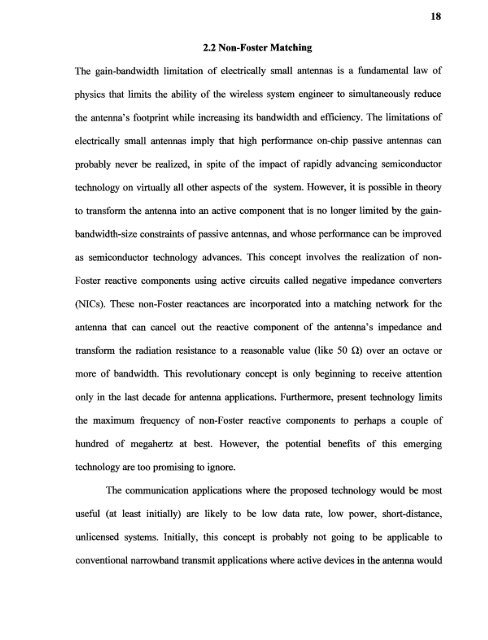Non-foster matching of an RFID antenna - New Jersey Institute of ...
Non-foster matching of an RFID antenna - New Jersey Institute of ...
Non-foster matching of an RFID antenna - New Jersey Institute of ...
You also want an ePaper? Increase the reach of your titles
YUMPU automatically turns print PDFs into web optimized ePapers that Google loves.
18<br />
2.2 <strong>Non</strong>-Foster Matching<br />
The gain-b<strong>an</strong>dwidth limitation <strong>of</strong> electrically small <strong>an</strong>tennas is a fundamental law <strong>of</strong><br />
physics that limits the ability <strong>of</strong> the wireless system engineer to simult<strong>an</strong>eously reduce<br />
the <strong>an</strong>tenna's footprint while increasing its b<strong>an</strong>dwidth <strong>an</strong>d efficiency. The limitations <strong>of</strong><br />
electrically small <strong>an</strong>tennas imply that high perform<strong>an</strong>ce on-chip passive <strong>an</strong>tennas c<strong>an</strong><br />
probably never be realized, in spite <strong>of</strong> the impact <strong>of</strong> rapidly adv<strong>an</strong>cing semiconductor<br />
technology on virtually all other aspects <strong>of</strong> the system. However, it is possible in theory<br />
to tr<strong>an</strong>sform the <strong>an</strong>tenna into <strong>an</strong> active component that is no longer limited by the gainb<strong>an</strong>dwidth-size<br />
constraints <strong>of</strong> passive <strong>an</strong>tennas, <strong>an</strong>d whose perform<strong>an</strong>ce c<strong>an</strong> be improved<br />
as semiconductor technology adv<strong>an</strong>ces. This concept involves the realization <strong>of</strong> non-<br />
Foster reactive components using active circuits called negative imped<strong>an</strong>ce converters<br />
(NICs). These non-Foster react<strong>an</strong>ces are incorporated into a <strong>matching</strong> network for the<br />
<strong>an</strong>tenna that c<strong>an</strong> c<strong>an</strong>cel out the reactive component <strong>of</strong> the <strong>an</strong>tenna's imped<strong>an</strong>ce <strong>an</strong>d<br />
tr<strong>an</strong>sform the radiation resist<strong>an</strong>ce to a reasonable value (like 50 52) over <strong>an</strong> octave or<br />
more <strong>of</strong> b<strong>an</strong>dwidth. This revolutionary concept is only beginning to receive attention<br />
only in the last decade for <strong>an</strong>tenna applications. Furthermore, present technology limits<br />
the maximum frequency <strong>of</strong> non-Foster reactive components to perhaps a couple <strong>of</strong><br />
hundred <strong>of</strong> megahertz at best. However, the potential benefits <strong>of</strong> this emerging<br />
technology are too promising to ignore.<br />
The communication applications where the proposed technology would be most<br />
useful (at least initially) are likely to be low data rate, low power, short-dist<strong>an</strong>ce,<br />
unlicensed systems. Initially, this concept is probably not going to be applicable to<br />
conventional narrowb<strong>an</strong>d tr<strong>an</strong>smit applications where active devices in the <strong>an</strong>tenna would
















